Excerpts from Jim Conrad's
Naturalist Newsletter
from the March 11, 2018 Newsletter issued from Rancho Regenesis in the woods ±4kms west of Ek Balam Ruins; elevation ~40m (~130 ft), N~20.876°, W~88.170°; central Yucatán, MÉXICO
PIÑUELAS FLOWERING
In the woods not far from the rancho a dense colony of Piñelas presented the view shown below:
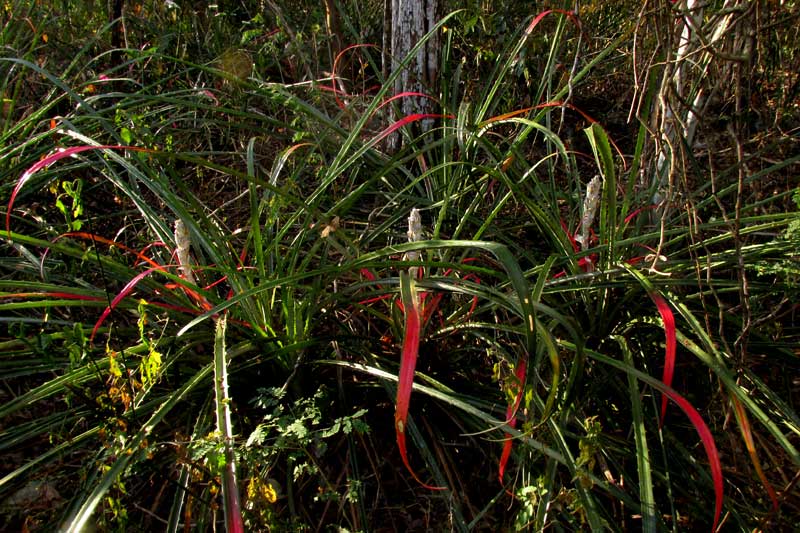
Note that some of the blades on these plants are red, plus there are white, slender items arising from the centers of individual plants. A close-up of one is below:
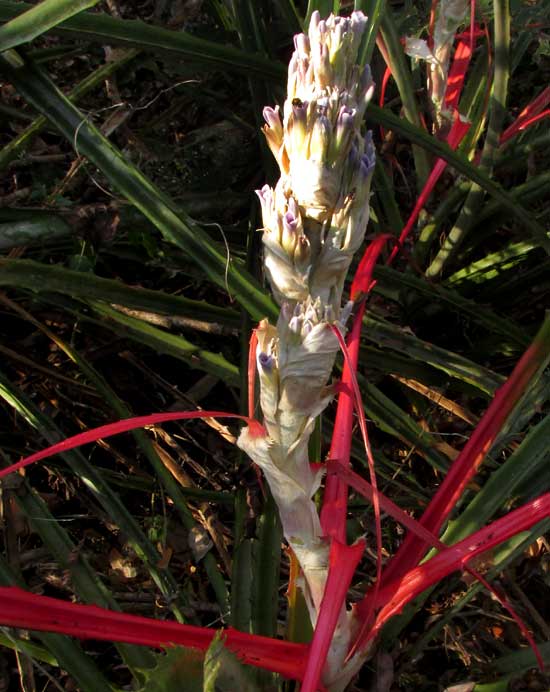
It's a flowering head, as indicated by the clusters of pale lilac corollas arising along the stalk's sides. A close-up of flowers bunched at the inflorescence's top is shown below:
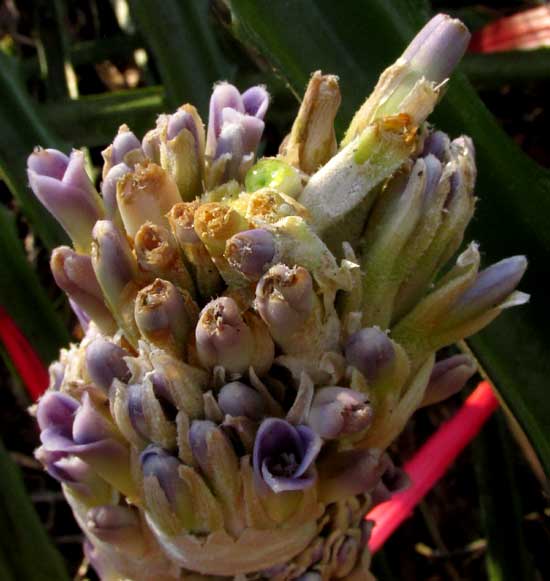
An individual flower removed from the inflorescence, with its corolla on the right, its papery, sharp-pointed sepals in the middle, and its fuzz-covered inferior ovary on the left, is shown below:
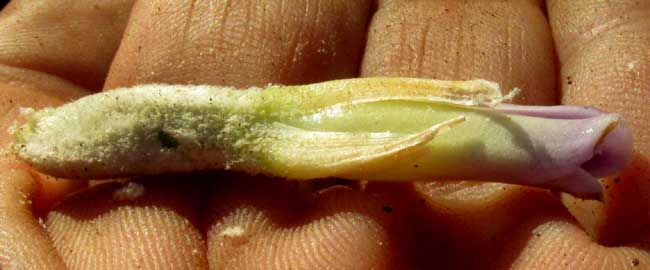
When the corolla is broken open, you can see the flower's six stamens, as shown below:

One last photo of this plant's broad-based, hook-tipped, leaf-tip-pointing spines effectively arranged along each leaf's margins -- so that reaching into the plant's center is a tricky business -- is shown below:

Here we're looking at a different species from the Bromelia karatas nowadays producing mature fruits in dense clusters in the plants' centers, pie-like, close to the ground. The present plant's flowers obviously are held well above the ground on a conspicuous stalk. The two species' rosette-forming, long, slender, hooked-spine-armored leaves are so similar that at first I didn't recognize that here we have two Piñuela species. Both species commonly occur here in forest that hasn't been cleared for a few years, and they intermingle so indifferently that so far I haven't noticed any difference in habitat preference between them.
Our inflorescence-stalk-forming Piñuela is BROMELIA PINGUIN, native to Mexico and the Caribbean area, south to Brazil. It's reportedly naturalized in Florida. In Jamaica its commonly planted as a fence around pasture lands, on account of its prickly leaves.
I read that here in the Yucatan people treat the whooping cough, tos ferina, with a tea made of this species, brewed with menta, which I assume to be Spearmint, as well as poleo, another kind of mint, and toronjil, which is grapefruit.
from the March 18, 2018 Newsletter issued from Rancho Regenesis near Ek Balam ruins in Yucatán, MÉXICO
PIÑUELA FLOWERING HEADS SPREADING OUT
One week after the above pictures were taken, most of the Piñuelas' flowering is past and the slender inflorescences have opened up to an oval shape, revealing that flowers rest atop short stems, or pedicels, as shown below:
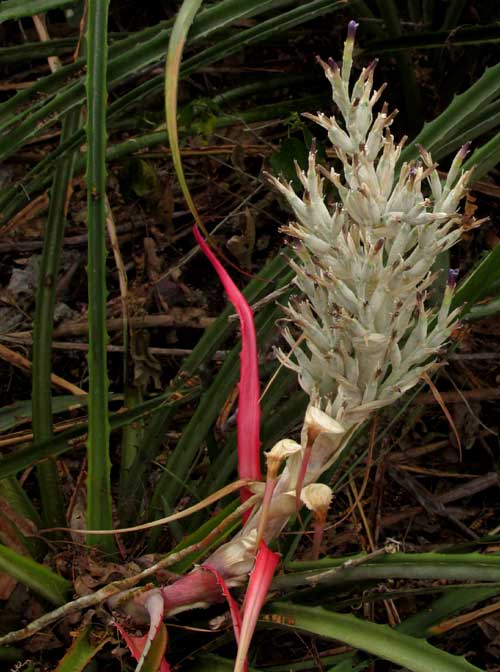
Most pictures on the Internet show the inflorescences in this more mature stage, but now we see that, at least here and now, our flowering heads expand only after the flowering peak is past.
from the July 27, 2018 Newsletter issued from Rancho Regenesis in the woods ±4kms west of Ek Balam Ruins; elevation ~40m (~130 ft), N~20.876°, W~88.170°; central Yucatán, MÉXICO
PIÑUELA FRUITS TURNING ORANGE
Nowadays our Piñuelas' fruits are full sized and turning yellowish orange, as shown below:
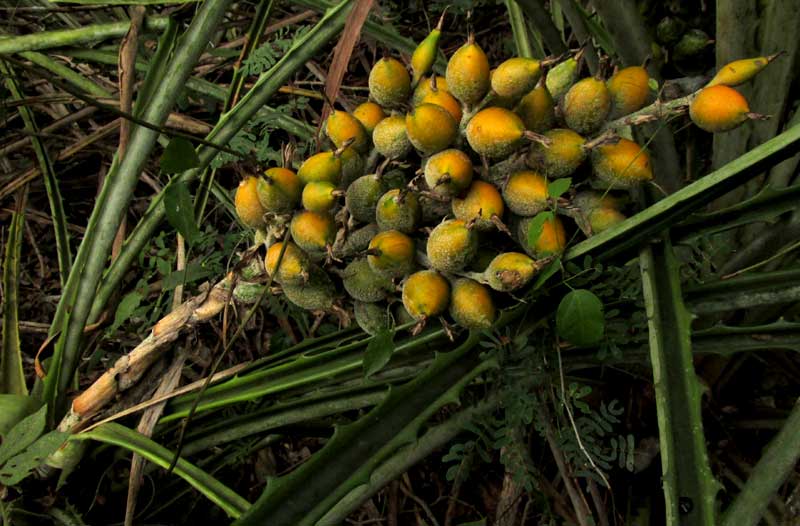
The fruits still have some time before they're ripe enough for producing viable seeds. It's interesting that the yellowish orange color is the same appearing on fruits of closely related pineapple plants as they begin to mature. Pineapple fruits keep this color for weeks, though, before they become soft and sweet enough to eat, and I suspect it'll be weeks before these fruits are ripe, too.
from the November 30, 2018 Newsletter issued from Rancho Regenesis near Ek Balam ruins in Yucatán, MÉXICO
PIÑUELA FRUITS RIPENING
Though the fruits began turning yellow in July, only now are they mature. I realized this when I noticed that something -- probably a rodent -- had begun chewing on some of the fruits, as you can see below:

The gnawed-on fruits are those a the picture's bottom with white, pulpy material exposed.
Interestingly, the flowers had been borne on erect stalks arising from the center of the plants' rosettes of long, stiff, spiny blades. When the fruits were just beginning to turn yellow, the stalks began leaning to one side. Now I can't find a single stalk that has not collapsed so that its heavy load of ripe fruits rests on the ground, as is the case below:
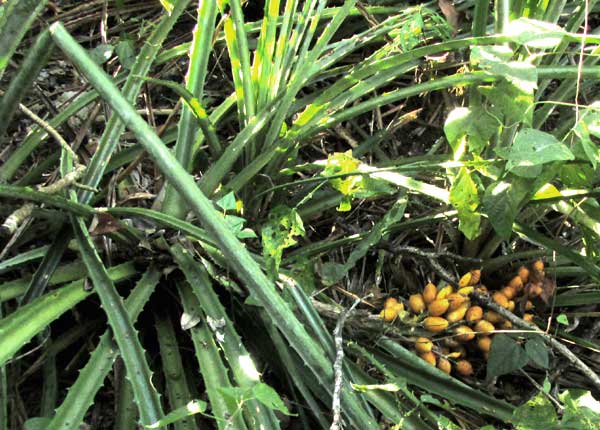
When I sampled the other Piñuela's ripe fruit, I found them sweet and a bit like pineapple, though very seedy. This species' fruits were slightly juicy but to me had very little sweetness or similarity to pineapple. Below, you can see what a split-open mature fruit looks like:

I'll bet the forest rodents like them enough, though, to eat plenty, then in their intestines carry the seeds to new territories where in their poop they plant new Piñuelas.